By Dave McCracken
Before vack-machines arrived on the scene, we had to clean the bedrock traps using wisk-brooms, wash-brushes and sometimes even toothbrushes.

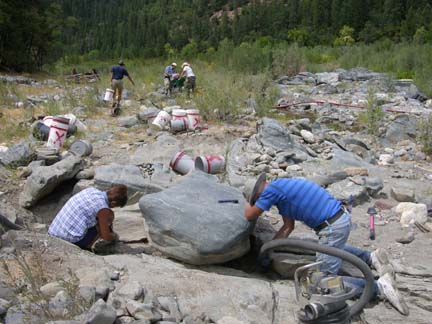
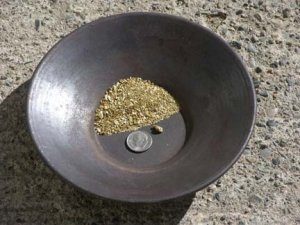 This story is dedicated to Mary Taylor, who is one of the most enthusiastic and dedicated gold prospectors that I have ever met. Mary will always be a welcome participant on any of the group mining projects that we organize!
This story is dedicated to Mary Taylor, who is one of the most enthusiastic and dedicated gold prospectors that I have ever met. Mary will always be a welcome participant on any of the group mining projects that we organize!
Happy Camp is a great place to be during the summer months. The weather is nice. The water in the river is low, allowing optimum access to high-grade gold deposits alongside the edge of the waterway.
There were nine of us participating on this surface mining project during the early days of August. By surface mining, I mean prospecting for and developing gold deposits that are located outside of the active waterway. We do six 2-day (weekend) surface mining group projects and one or two week-long surface group mining projects each season. We also do several week-long dredging projects. Everyone who participates is rewarded with an equal share of all the gold that is recovered during a project.
Even though we usually recover plenty of gold, most people that participate say the team-building and learning experiences during these projects are worth more than gold.
I find that we generally do as good on these projects as we are able to pull together in a team effort. So I was optimistic at the beginning of the week that we were going to recover plenty of gold on this project. Everyone showed up eager to work and enthusiastic about just being there.
Having well over 60 miles of mining property to choose from (actually 120 miles when you count both sides of the river), we have plenty of choices where to do our surface mining projects. This time, though, we decided that we would begin on the far side of the Klamath River, just downstream from Savage Rapids, on K-15A. This claim was named the “Mega-Hole” years ago, because it produced so much gold for so many members. In fact, the area across the river where we were going to start had previously been thoroughly mined by members during the early 90’s.
Several days before this project started, I was driving past the Mega-Hole and spotted a lady walking up the bank towards the road with a bunch of prospecting supplies in her arms. So I pulled right over to speak with her. I seldom pass up an opportunity to speak to members who are actively prospecting or mining along our claims. This is how I gather most of the information which adds up to the hot prospecting leads that we follow during these group projects!
Anyway, she showed me a pretty impressive amount of gold that she had panned on the far side of the river. Her husband was in the process of paddling their small raft across the river with a second load of prospecting gear. He had even more gold than his wife to show for his effort. I could see where they had been digging. The amount of gold they recovered was impressive for what they had done.
The interesting thing is that the area where they were digging had already been mined by members in the past!
As we were talking alongside the road, Jake Urban and Lily Fuller pulled their vehicle off the highway to see what was going on. Jake and Lily are long-time active New 49’er members and very experienced prospectors. So they also know better than to drive past New 49’er members who are discussing gold prospects alongside the road.
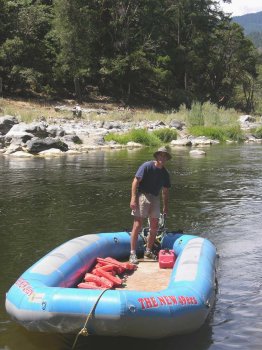 The next day, Jake and Lily told me that they had already crossed the river with gold pans to check out the area. They told me that the whole bar on the other side appeared to consist of hard-packed streambed that was paying with gold. So we came up with the theory that the whole area must have been re-deposited with hard-pack and high-grade gold during the big flood of 1997. This was good!
The next day, Jake and Lily told me that they had already crossed the river with gold pans to check out the area. They told me that the whole bar on the other side appeared to consist of hard-packed streambed that was paying with gold. So we came up with the theory that the whole area must have been re-deposited with hard-pack and high-grade gold during the big flood of 1997. This was good!
So that’s where we found ourselves on the first day of this group mining project. Our plan was to begin with some pan-sampling on the bar across the river. We were using one of the Club’s large rubber rafts. If we didn’t find something exciting over there, using the raft, we were going to continue sampling the far side of the river on down through K-15A and into the “Glory Hole” (K-15). The Glory Hole is an extension of the rich Mega-Hole area. Having a full week to prospect around, we were confident that we would find some high-grade to work in that 2-mile stretch of river. That whole area is very productive for surface mining, because there is so much exposed bedrock everywhere. A lot of the other side has never been touched, because a boat or raft is required to get gear over there.
It only took about 15 minutes on the far side of the river before I started hearing hoops and hollers from those who had already started taking pan samples. In fact, the gold was rich enough that the participants immediately started firing up their vack-mining machines.
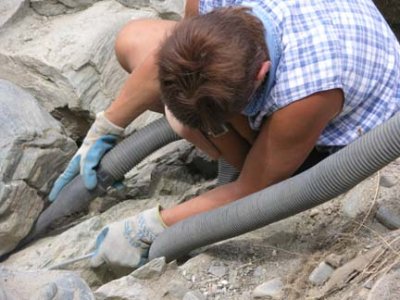
Vack-mining machines are powerful motorized vacuums which have been adapted to suck rocks, sand and gravel up into a 5-gallon bucket. Sometimes they are called “dry-land dredges.” Vack-machines allow you to clean out the inside of cracks and crevices along the bedrock where concentrations of gold are often trapped during major flood storms. Before vack-machines arrived on the scene, we had to clean the bedrock traps using wisk-brooms, wash-brushes and sometimes even toothbrushes. Those days are now pretty-much over.
Vack-mining exposed bedrock to recover high-grade gold alongside active waterways is growing in popularity amongst modern gold prospectors, especially with people that do not wish to dredge in the active river. It is less difficult to do than pick-and-shovel mining, but can be more productive in the right kind of areas.
Normally during these projects, I manage every phase of the program; especially at the point where we switch from sampling to production. But the excitement over the gold everyone was finding did not allow me the opportunity this time. Within the first hour of being on the other side of the river, the participants had already organized themselves into a production team and were asking me to bring the high-banker over in the raft.
Mostly, they were finding hard-packed streambed material that was around a foot deep on top of bedrock. Fine and flake gold were disbursed throughout the hard-pack, but the richest values were inside the bedrock traps. Those using the Vack-machines were doing a great job to get the gold out of those cracks!
We worked out a team program where several of us were shoveling material into buckets and loading them to a single high-banker. Two others were processing the material through the high-banker. And several others were using vack-machines to thoroughly clean the bedrock. Once an area was finished, we rolled the rocks back generally to their original places to reclaim the area.
A high-banker is a surface mining recovery devise that we use to process gravels. The trick is to feed material at a uniform rate so that gold recovery is optimized. Our team was in the spirit of doing things right even before we set the high-banker up! It did not take us long to get into a steady pace whereby the high-banker was processing material at about the same speed as we were able to deliver it up in buckets. We were in production even before lunch on the first day!
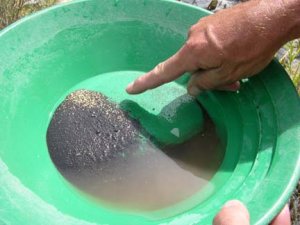 As is usually the case, my long-time, very experienced assistants, Craig Colt and Dick Bendtzen, were participating on this project. Under normal circumstances, they do a lot of the work in the early stages of prospecting to help us locate a high-grade deposit. That was not necessary this time around. Once we got things started, Dick devoted some effort to locate the outside boundaries of the pay-streak that we were working. You do this by extending pan-samples outward until you discover where the gold deposit is not as rich. The pay-streak turned out to be pretty large; about 30 feet wide by about 70 feet long! Once the boundaries were established, we focused on working only the hard-pack inside the known pay-streak.
As is usually the case, my long-time, very experienced assistants, Craig Colt and Dick Bendtzen, were participating on this project. Under normal circumstances, they do a lot of the work in the early stages of prospecting to help us locate a high-grade deposit. That was not necessary this time around. Once we got things started, Dick devoted some effort to locate the outside boundaries of the pay-streak that we were working. You do this by extending pan-samples outward until you discover where the gold deposit is not as rich. The pay-streak turned out to be pretty large; about 30 feet wide by about 70 feet long! Once the boundaries were established, we focused on working only the hard-pack inside the known pay-streak.
Craig, being the younger guy on our team, usually sets the work pace when we get into production. This also was not necessary on this project, because Mary Taylor had already established a respectable pace even before Craig stepped off the raft!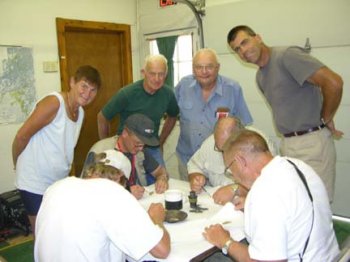
As the days went by, we fell into a routine, cleaning up the higher-grade portion of the recovery system when we broke for lunch, and then the whole recovery system at the end of each day. We were using gold pans to work our concentrated material down far enough to get a look at the gold we were recovering. It was good! All the concentrates were saved in a bucket until the last day of the project.
Under normal circumstances on these projects, we usually sample around for a day or two before we locate a deposit that is rich enough to develop with a production plan. In this way, participants gain valuable exposure to the sampling process. So about mid-way through the week on this particular project, I started getting concerned that the participants were not going to experience any sampling activity. 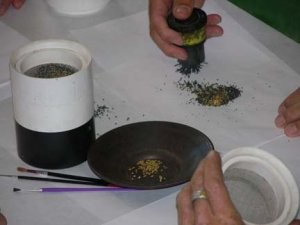
I like to engage participants in some debate concerning all of the important decisions we make on these projects. The reason is that the choices we must make are similar in most prospecting programs. Each choice is a crossroads which will have an important impact upon the final result. Including everyone in the ongoing decision-making process includes an educational perspective that can be helpful later when participants go off on their own.
When I brought up the idea of quitting the area about mid-week to go look for some new deposits, there was not much of a debate. This was the richest gold deposit the participants had ever mined. We were staying! 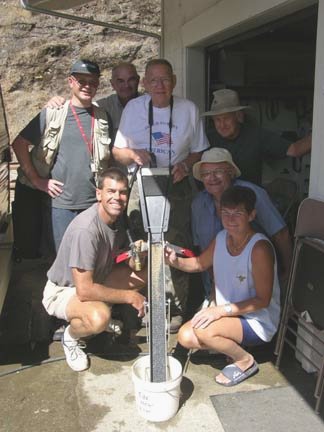
It takes too long to do a full clean-up of our gold every day during these projects. So we save the concentrates from the high-banker until the final day, and then we clean them up back at the office. All participants help with every step of the process. We use several devices to remove as much of the iron particles as possible, dry the final material and then do a final separation using a magnet and a mild blowing action.
Separating the gold from the final concentrate and splitting it all up is always the highlight of the week. It is when we all experience the rewarding feelings associated with being part of a team spirit while recovering some of mother-nature’s golden treasure. True and lasting friendships are made on these projects.





